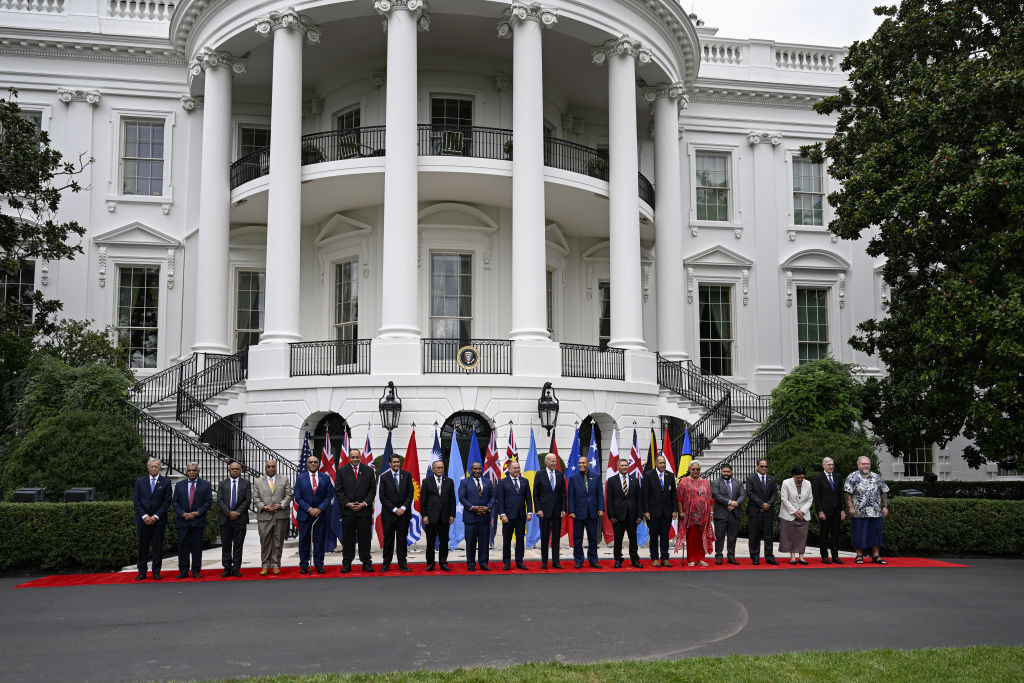
At the US Institute of Peace’s Interorganizational Global Forum on security cooperation in the Pacific islands in September, the US emphasised a ‘whole-of-government effort’ in engaging with the region that involves cabinet-secretary-level meetings, an intelligence briefing on matters such as illegal fishing and climate migration, strengthening the US Peace Corps’ presence and touring the US Naval Academy’s rugby team. While these are reasonable first steps, the forum highlighted three other things the US needs to do better: listen to its own Pacific experts, invest in the Pacific’s regional architecture and reframe the traditional security dialogue.
At the forum, a senior US official described how the US gets the bulk of its Pacific history and background ‘from Australia and New Zealand’. There are indeed many well-known regional security experts worth listening to, like Anna Powles, Tess Newton-Cain, Jose Sousa-Santos, Meg Taylor and William Waqavakotoga—especially if their views are disagreeable to the US.
That said, there’s a growing number of US citizens with Pacific expertise whose insight would help boost the US–Pacific relationship and strengthen the region’s security as outlined in the 2050 Strategy for the Blue Pacific Continent.
To name a few: Dana Lee Ling at the College of Micronesia knows more about ethnobotany than perhaps any other American in Micronesia; Clark Graham has lived in Chuuk since the time of the Trust Territory of the Pacific Islands and runs Chuuk’s premier private school for elementary students; Natalie Nimmer and Tamara Greenstone-Alefaio have extensive experience in Marshall Islands and the Federated States of Micronesia in the fields of education and environment; and Jack Niedenthal, Thane Hancock and Eileen Natuzzi have saved thousands of lives through their medical expertise.
US citizens like these know the North Pacific’s cultural and political histories, education and healthcare systems, and environmental issues and have witnessed firsthand the vulnerabilities Pacific islanders face. The US government needs to recognise and listen to such experts.
The US must also pay attention to the Pacific’s regional architecture. Virtually every Pacific islander at the forum emphasised that, while bilateral relations are important, more must be done to acknowledge organisations such as the Pacific Islands Forum, the Pacific Community and the Forum Fisheries Agency. Just being perceived to be undermining such architecture can damage US relations with development partners.
The solution is simple: the US should provide the bulk of its funding that’s unrelated to the Compacts of Free Association through the Pacific Islands Forum and the Council of Regional Organisations of the Pacific. By treating these organisations with the respect Pacific islanders are asking for, the US will accrue the soft power it seeks. The US should also make sure to send an envoy to the Pacific Islands Forum who is culturally aware—who knows not to wear pants when meeting the king of Tonga and is happy to drink sakau with Pohnpeians. Then the US principles of peace, liberty, democracy, human rights and justice may be better amplified throughout the region.
The US must also reconsider how traditional security issues are discussed. On the margins of the forum, former and current US officials privately commented on anti-US sentiment among some Pacific islanders. They gave examples of people equating China’s militarisation and its efforts in the South China Sea to the US Armed Forces’ build-up in Guam. There was also talk about hostility towards AUKUS and its relationship to nuclear-powered submarines, and the fortification of Guam and Palau with dual-use facilities. At least four islanders said, ‘We are not naive’ in reference to the defence build-up in the region; understandably they would prefer their homes not to become battlegrounds as they did in World War II.
Islanders are right about the dangers of conflict—my former boss, David Panuelo, became increasingly worried about a kinetic conflict during his service as president of the FSM. And yet the US and Australia only say that the security situation in the Pacific has deteriorated without sharing enough details as to why and how.
As his press secretary, I ensured that Panuelo received briefings on China’s movements in the region, including its nuclear-powered (and nuclear-equipped) submarines passing through the Pacific, its dual-use research vessels’ activities in the FSM, its militarisation of the South China Sea and its infringements on the Philippines’ coastal territory. If, for example, the Pacific Islands Forum secretary-general doesn’t have access to similar information, the US and Australia must ensure that Pacific governments receive enough intelligence to make informed decisions.
In fending off China’s presence in the Pacific, it can be tempting for the US to frame its strategy as a game of StarCraft: factories, command centres and supply lines are enemy targets, and kinetic conflict is deterred by building missile defences and other assets. But what Pacific islanders want is for the US to show the same level of attention to the vulnerabilities they face domestically—poverty, domestic violence, climate change, and career and educational challenges. If the US can forge a genuine partnership of respect with the Blue Pacific Continent, then those democratic sovereign nations will choose an America-led international order on its own merits, regardless of the very real threats from autocratic and authoritarian China.

